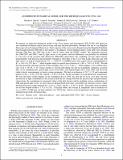AN IMPROVED DYNAMICAL MODEL FOR THE MICROQUASAR XTE J1550–564
Author(s)
Orosz, Jerome A.; Steiner, James F.; McClintock, Jeffrey E.; Torres, Manuel A. P.; Bailyn, Charles D.; Miller, Jon M.; Remillard, Ronald A; ... Show more Show less
DownloadOrosz-2011-AN IMPROVED DYNAMICA.pdf (974.8Kb)
PUBLISHER_POLICY
Publisher Policy
Article is made available in accordance with the publisher's policy and may be subject to US copyright law. Please refer to the publisher's site for terms of use.
Terms of use
Metadata
Show full item recordAbstract
We present an improved dynamical model of the X-ray binary and microquasar XTE J1550–564 based on new moderate-resolution optical spectroscopy and near-infrared photometry obtained with the 6.5 m Magellan Telescopes at Las Campanas Observatory. Twelve spectra of the source were obtained using the Magellan Echellette Spectrograph between 2008 May 6 and August 4. In addition, several hundred images of the field were obtained between 2006 May and 2009 July in the J and K[subscript S] filters using the PANIC camera. The agreement between the 2006/2007 and 2008 J and K[subscript S] light curves is not perfect, and the differences can plausibly be attributed to a hot spot on the accretion disk during the 2006/2007 observations. By combining our new radial velocity measurements with previous measurements obtained in 2001 May at the 8.2 m Very Large Telescope and with light curves, we find an orbital period of P = 1.5420333 ± 0.0000024 days and a radial velocity semiamplitude of K [subscript 2] = 363.14 ± 5.97 km s[superscript –1], which together imply an optical mass function of f(M) = 7.65 ± 0.38 M [subscript ☉]. We find that the projected rotational velocity of the secondary star is 55 ± 5 km s[superscript –1], which implies a very extreme mass ratio of Q ≡ M/M [subscript 2] ≈ 30. Using a model of a Roche lobe-filling star and an azimuthally symmetric accretion disk, we fit simultaneously optical light curves from 2001, near-infrared light curves from 2008, and all of the radial velocity measurements to derive system parameters. We find an inclination of 74[° over .]7 ± 3[° over .]8 and component masses of M [subscript 2] = 0.30 ± 0.07 M [subscript ☉] and M = 9.10 ± 0.61 M [subscript ☉] for the secondary star and black hole, respectively. We note that these results depend on the assumption that in 2008, the disk did not have a hot spot, and that the fraction of light contributed by the accretion disk did not change between the spectroscopic and photometric observations. By considering two measured values of the disk fraction and by modeling various combinations of NIR and optical light curves, we show that our adopted black hole mass is probably not seriously in error, where the black hole mass ranges between M = 8.91 ± 1.10 M [subscript ☉] and M = 13.94 ± 1.64 M [subscript ☉]. The radius of the secondary star for the adopted model is 1.75 ± 0.12 R [subscript ☉]. Using this radius, the average K[subscript S] magnitude, and an extinction of A[subscript K] = 0.507 ± 0.050 mag, we find a distance of 4.38[+0.58 over –0.41] kpc, which is in good agreement with a recent distance estimate based on H I absorption lines.
Date issued
2011-03Department
MIT Kavli Institute for Astrophysics and Space ResearchJournal
The Astrophysical Journal
Publisher
IOP Publishing
Citation
Orosz, Jerome A., James F. Steiner, Jeffrey E. McClintock, Manuel A. P. Torres, Ronald A. Remillard, Charles D. Bailyn, and Jon M. Miller. “AN IMPROVED DYNAMICAL MODEL FOR THE MICROQUASAR XTE J1550–564.” The Astrophysical Journal 730, no. 2 (March 7, 2011): 75. © 2011 The American Astronomical Society
Version: Final published version
ISSN
0004-637X
1538-4357